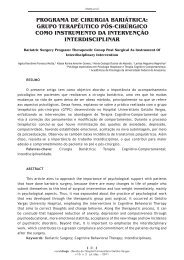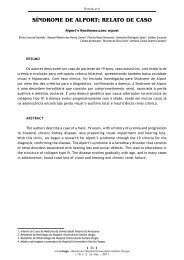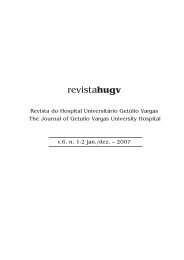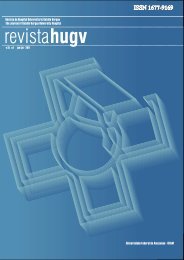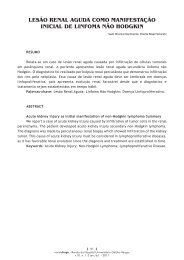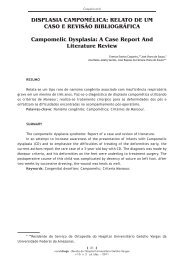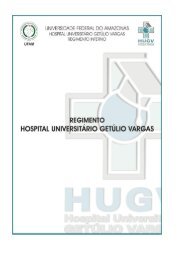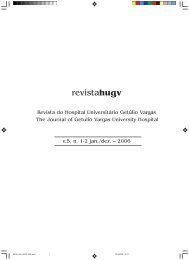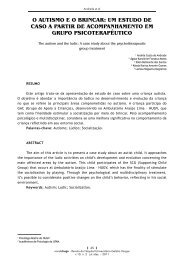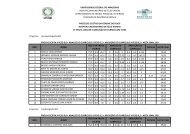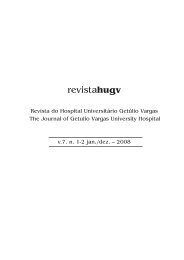Revista HUGV 2006 - Hospital Universitário Getúlio Vargas - Ufam
Revista HUGV 2006 - Hospital Universitário Getúlio Vargas - Ufam
Revista HUGV 2006 - Hospital Universitário Getúlio Vargas - Ufam
You also want an ePaper? Increase the reach of your titles
YUMPU automatically turns print PDFs into web optimized ePapers that Google loves.
CARAARACTERIZACTERIZAÇÃÇÃO DAS REAÇÕESTRANSFUNSIONAIS AIS OCORRIDORRIDAS NO HOSPITAL UNIVER-SITÁRIO GETÚLIO VARARGASAS, , AMAZONASAS, , BRASIL, NO PE-RÍODO DE 2001 A 2003CHARATERIZATION OF TRANSFUNSIONAL REACTIONS OCCURED IN THE UNIVERSITY HOSPITALGETÚLIO VARGAS, AMAZONAS, BRAZIL, IN THE PERIOD OF 2001 TO 2003Miharu Maguinoria Matsuura Matos * , Rivaldo Castro Vilar**, Yvelise Ferreira***,Reneide de Pinheiro Almeida****, Maria Elizete de Almeida Araújo*****RESUMO: Diante do complexo quadro que envolve a prática transfusional, aliada ao fato de que o Estado doAmazonas possui dados incipientes referente às reações transfusionais, o presente estudo propôs descrever asreações ocorridas no <strong>Hospital</strong> Universitário Getúlio <strong>Vargas</strong>, da cidade de Manaus, Brasil. Acredita-se que as informações,apresentadas neste estudo, contribuem para o conhecimento real das reações transfusionais ocorridas epossibilita o aprimoramento do trabalho desenvolvido pela Hemovigilância do <strong>HUGV</strong>, permitindo uma maiorsegurança transfusional. Casuística: Avaliação de todos os relatórios de reação transfusional e livros de registro detransfusão sangüínea do banco de dados da Agência Transfusional do hospital, no período de 2001 a 2003. Resultados:Das 21.289 transfusões analisadas, 21 desencadearam reações transfusionais, caracterizando uma freqüênciade 0,10%. A incidência de reação alérgica foi de 0,04% e reação febril não hemolítica foi de 0,03%. Esses dadosdiferem dos disponíveis na literatura quanto à incidência, mas é similar quanto aos tipos de reação maisfreqüentes. Conclusões: Observou-se uma baixa taxa de reação transfusional refletindo que existem dificuldadesna monitorização e notificação das reações ocorridas neste hospital. Considera-se que essa taxa foi influenciadapor diversas causas, principalmente em conseqüência das subnotificações, pois representa uma inconsistência dadefinição de caso por falta de conhecimento técnico-científico dos envolvidos na terapia transfusional.Palavras-chave: Reações transfunsionai, transfunsão sanguínea, hemovigilância, Incidentes transfunsionais, notificaçãode reações adversas.ABSTRACT: Facing the complex situations that involves the transfusional practice, followed by the fact that thestate of Amazon doesn´t have enough information about transfusional reactions, the present study proposed todescribe the reactions occured in the University <strong>Hospital</strong> Getulio <strong>Vargas</strong> in Manaus, Brazil. It is believed credit thatthe information in this study contribute to the real knowledge of transfusional reactions occured and offer theimprovement of the work developed by the Hemovigilance of <strong>HUGV</strong>, allowing a higher transfusional security.Material and methods: Review of all the reports of transfusional reaction and the blood transfusions registers of thedata base of the Transfusional Agency of the hospital in period of years from 2001 to 2003. Results: Of 21,289transfusions analyzed, 21 had transfusional reactions, characterizing a frequency of 0,10%. The alergical incidenceof reactions was 0,04% and no hemolytic fever reaction was 0,03%. These data differ from the available literature inincidence terms but it was similar to the types of reaction found in this study. Conclusions: A low tax of transfusionalreaction was observed in this study reflecting the existence of difficulties in the monitorization and notificationof the reactions occurred in this hospital. It is considered that this tax was influenced by several causes, mainly dueto subnotifications, that represent an inconsistency of the case definition due to technician-scientific knowledge ofthe people involved in the transfusional therapy.Keywords: Transfusional reactions. Blood transfusion. Hemovigilance. Transfusional incidents. Notification ofadverse reactions.*Farmacêutica-Bioquímica, <strong>HUGV</strong>, <strong>Ufam</strong>**Farmacêutico-Bioquímico, <strong>Ufam</strong>***Médica, Hemoam****Farmacêutica-Bioquímica, <strong>HUGV</strong>, Hemoam*****Gerente de Risco Sanitário <strong>Hospital</strong>ar, <strong>HUGV</strong>, <strong>Ufam</strong>revistahugvhugv – <strong>Revista</strong> do <strong>Hospital</strong> Universitário Getúlio <strong>Vargas</strong>v. 5. n. 1-2 jan./dez. – <strong>2006</strong>11




